A Two-Pronged Strategy Towards Empowering People with Disabilities: Lessons from Arushi, Bhopal
By Shefali Tripathi Mehta and Ankur Madan
1.Introduction
A typical, non-disabled person if they have to walk a two-hundred meter stretch on a public road must negotiate potholes, non-existent pavements, which if present, may be deceptively dangerously, dug up, with mounds of debris, animal poop, hanging electrical wires and very often, rashly driven two-wheelers. How does a person in a wheelchair; one who cannot see; one who cannot hear; someone who is a little slow on their feet or in reacting to new situations, be expected to ever negotiate these perilous labyrinths that are our public spaces? Are they or their caregivers wrong in dissuading them to venture out? To not leave the safe confines of their homes and maybe a few other places? Transport, services, infrastructure, public places – schools, colleges, offices, marketplaces, banks, cinema halls, parks – are all designed to serve and suit the needs of the non-disabled population.
According to the Census 2011, there are 2.68 crore people with one or multiple disabilities in the country (this number is refuted by independent organizations and people working with people with disabilities (PWDs); even the World Bank puts this figure between 4-8 crore). It is not as if the state has completely ignored their existence. Apart for the four laws that are overall meant to safeguard the interests of this group, including the RPWD Act of 2016, there are numerous entitlements and concessions, granted both by the central and the state governments. The lacuna is in the proper dissemination of information at the governance level and the awareness and means of accessing these by this marginalized group. But besides physical access, the problems arising out of the attitudes and mindsets of the majority population regarding disabilities and people with disabilities are persistent hurdles to a seamless inclusion of people with disabilities with the rest.
Arushi is a Bhopal-based not-for-profit organization working with and for PWDs. It was instituted in 1992 by a group of socially-aware and socially-inclined young men, two of who are leading this organization today—Anil Mudgal and Rohit Trivedi. They started their work with blind students living in the government-run, Blind Relief Association. They began by forming a group that read out lessons to blind students. They moved to recording lessons on cassette tapes; accompanying the blind students as scribes during exams and were motivated to do more because they realized how complete the exclusion of PWDs from society is.
2. Overview of Activities
Overall, the focus of Arushi’s work is towards Inclusion—PWDs should be able to go everywhere and do everything that the rest do. Their approach is two-pronged. On the one hand, they empower PWDs and on the other, they sensitize people without disabilities about the needs, requirements and the capabilities of PWDs.
2.1 Empowerment of people with disabilities
From helping them with livelihoods to bringing care and cheer into their lives and providing first-class therapy and services, Arushi takes care of every aspect of the lives of PWDs who they work with. They provide counselling and support to parents and families which goes a long way in creating enabling conditions for children with disabilities to grow and do better in life.
2.1.1. Trips and meeting role models
Children with disabilities are taken outdoors into public places – malls, cafes, zoos, go-carting, cultural events, amusements parks and on trips to other cities where they visit beaches, mountains, monuments and museums. Even their families hesitate to take them along on holidays, given the immense struggle it is to deal with poor infrastructure, inaccessible transport and public places, absence of disabled-friendly toilets. Also, they believe that this effort would be of ‘no use’ to a child with disability.
On these visits, the children are taken to meet their role models from the field of arts, cinema and sports. These visits have given the children immense exposure and self-confidence, which is clear in their curiosity and body language when they meet visitors to the centre. An important aspect of these travels is that it is arranged by volunteers in the cities that they visit. Volunteers assume various responsibilities – of providing a place to stay, vehicles for transport or meals.
2.1.2. School-readiness program
At their pre-school, ‘Koshish’, children with disabilities who are below the age of five and not enrolled in schools are equipped with basic school readiness skills so that they can be admitted into regular schools at the earliest. The school provides physiotherapy, early language training/audio verbal therapy, Braille, orientation and mobility training and all required forms of physical and learning assistance to children with disabilities. Using the play-way method, special educators acquaint the children with auditory, visual and tactile stimuli. The educators are guided by factors such as the readiness of a child to learn and their emotional and physical abilities. The school also extends parental counselling, provision for special furniture where required and help with admission to regular schools with continued learning support.
2.1.3. Computer Training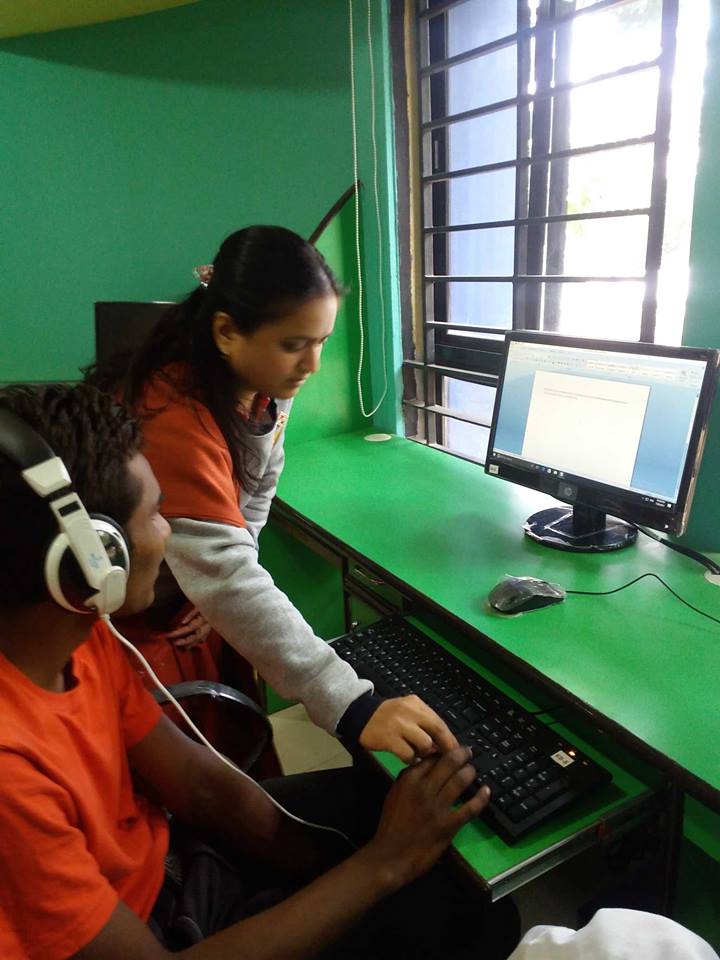
All children at Arushi are provided with basic computer literacy. Need-based training programs are also organized. Arushi also organizes computer training for persons with visual impairment from other states. The centre has a well-equipped computer room with over a dozen computers, all fitted with the necessary software for people with blindness and those who are deaf.
2.1.4. Disability Helpline
Arushi runs a toll-free helpline (1800-233-4397) supported by the Department of Social Justice, Government of Madhya Pradesh, to provide information on disability-related issues, such as pension, scholarship, marriage, loan, employment, self-employment. Nearly one hundred calls are received on this Helpline from all parts of India every day. The response is through IVRS but in many cases, they provide personalized information and counselling.
2.1.5. Talking-Books
Audio recording of books was their first initiative. The group came together to read out lessons to students who are blind or have visual impairment. They later began to record study material on used cassette tapes that they gave out to these students. Today, Arushi has an audio library with 50,000 hours of recorded study material for school and college students who are blind, visually- or print-impaired. Textbooks and instructional and supplementary materials for various disciplines are available on CDs.
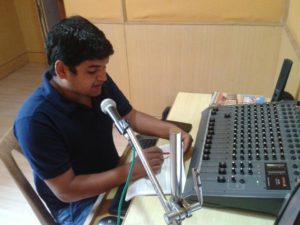
This work is completely voluntary. Volunteers, including students, housewives, elderly people and visiting celebrities record study materials in all languages for all subjects and students from many states use this service. The service is free for students and they can send any book to be recorded.
While a large number of students still use this service, in recent times, text-to-speech software available on mobile phones and devices allows blind students to access e-text from online libraries, so the focus is moving from audio recordings to e-Pub formats. At Arushi too, they are increasingly now, scanning and converting books into e-texts and then placing them into a digital library that PWDs can use from anywhere.
2.1.6. Braille transcription of books
Many students with blindness and low vision until the early ‘90s were studying and passing exams by listening to lessons and did not learn to read and write. Braille empowers these students by enabling them to be literate and not just educated. Arushi teaches all children with blindness to write in Braille. They also transcribe books in Braille on demand and have a selection of Braille books that they give out to school libraries, which schools rotate among themselves. Arushi conducts Braille classes for the general public too.
2.1.7. Accessibility
Arushi’s advocates for barrier-free public spaces and their efforts led to the opening of India’s first disabled-friendly bank way back in 1999—a branch of Central Bank of India which has ramps, railings and counters at low levels for wheelchair users.
Over the years, Arushi has worked relentlessly to make more and more public spaces barrier-free. Most of Bhopal’s public spaces, including the Indira Gandhi Rashtriya Manav Sangrahalaya (IGRMS), Regional Museum of Natural History, National Park, State Museum, Bharat Bhavan, Gauhar Mahal and Bhopal Haat are accessible with ramps, pathway and warning tiles, and information boards and signs in Braille. Similar work has been carried out in the museum and gardens at the Rashtrapati Bhavan, New Delhi; and a three-kilometre stretch of the Marine Drive, Mumbai.
Working with the Archaeological Survey of India (ASI), Arushi has made three famous monuments completely barrier-free – the world-famous Buddhist stupas, Sanchi; Tipu Sultan’s Summer Palace, Bangalore; and, the 7th century Laxman Temple, Sirpur, Chhattisgarh. In many other historical sites, like the Taj Mahal, Agra Fort, The Residency (Lucknow) to Sarnath temple—they have succeeded in getting information boards in Braille installed. With the help of the Bhopal Railway Division, Arushi has been successful in making the two railway stations in Bhopal completely disabled-friendly – the first and the only ones in India.
2.1.8. Aadhar
All government departments, both at the state and the central government level, offer various concessions to students with disabilities. The Ministry of Human Resources (Government of India), education departments and examination boards also issue guidelines and orders from time to time to help them. But the beneficiaries, their guardians, teachers and school authorities do not have access to relevant and updated information when required. Arushi has complied all the entitlements available to students with disabilities who are studying in mainstream schools and printed it in the form of a booklet called, ‘Aadhar’. This booklet is updated regularly.
2.2 Awareness and sensitization
A lot of their initial work was in communities, especially in slums where poverty leads to greater neglect of PWDs. And they are always finding new avenues to disseminate disability-awareness information. Arushi’s awareness programs are designed and delivered with the purpose of reducing barriers and increasing understanding, acceptance and inclusion of PWDs.
2.2.1. Posters, textbook pages, rail reservation forms
Around 120 posters on disability awareness produced by Arushi are used by government agencies and private organizations, including NGOs in Bangladesh, Sri Lanka and Pakistan to garner support for disability-related issues and to spread awareness. Translated in many Indian languages including Urdu, Assamese, Gurmukhi, Bengali and Telugu, the posters have been exhibited across the country. These are also displayed in railway stations (Northern Railways) and the Shatabadi Express trains. Disability awareness information is also printed on railway reservation forms to enable more and more people to understand and create enabling conditions everywhere.
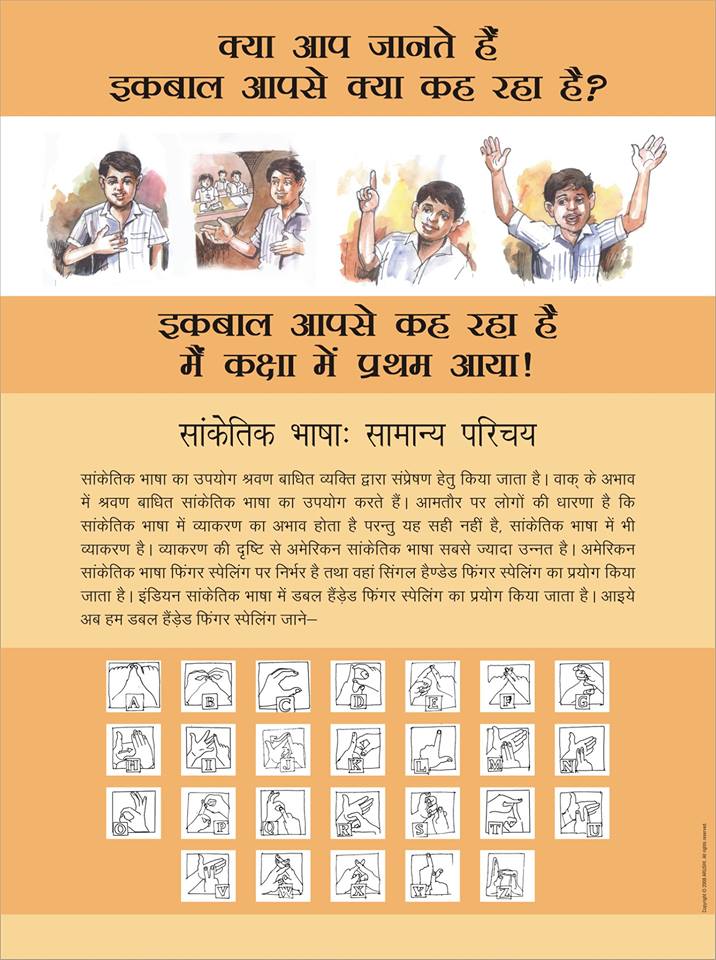
One-page on disability awareness and information on different aspects and types of disabilities has been included in all school textbooks from class one to eight in Madhya Pradesh and Chhattisgarh. These provide simple guidelines that educate and empower teachers, students, parents and other stakeholders.
2.2.2. Disability awareness and training programs
Arushi organizes weekly orientation workshops for public functionaries, such as community workers, NGOs, teachers, police personnel, industry and museum staff and the general public to familiarize them with the specific needs of PWDs. In these workshops, volunteers trained at Arushi offer simple and practical suggestions on how to interact more comfortably and confidently with PWDs.
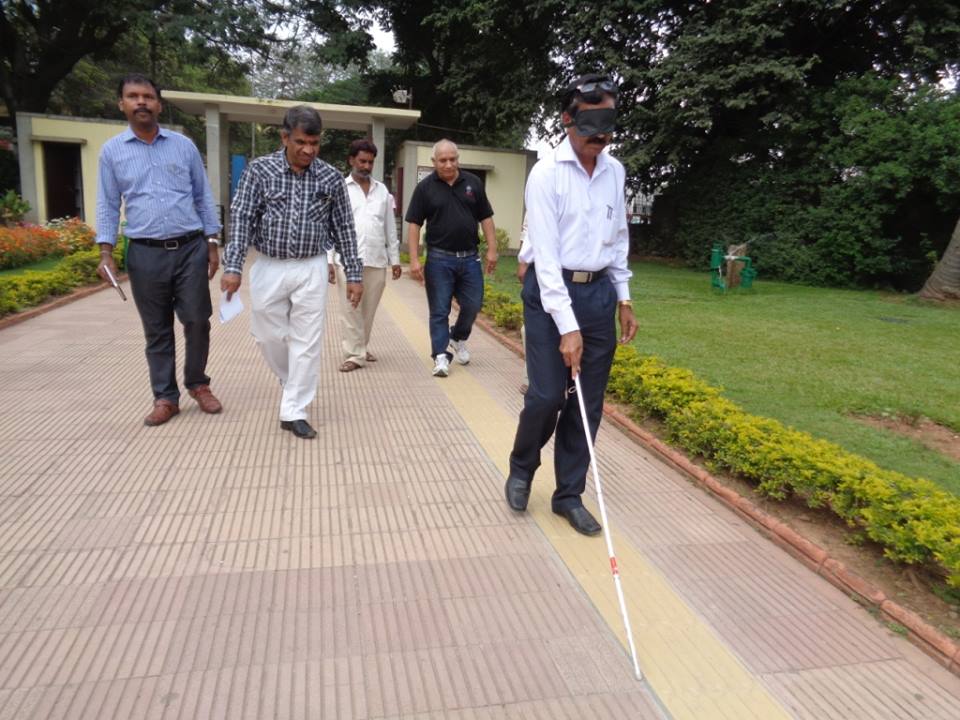
Arushi’s training in caring for tourists with disabilities is part of the essential training at the ASI. Every year, for a week, Arushi trains the staff and the guides at the Sanchi Stupas to sensitize them to the needs of tourists with disabilities, including wheelchair users and those with visual impairment. Volunteers of Arushi have conducted training and awareness programs at other historical sites in Madhya Pradesh, such as Bhimbetka caves, Bhojpur, Khajuraho and Mandu.
School and college students, employees of various organizations, artists and well-known personalities from all over the world visit Arushi and are acquainted with Braille, Sign Language, and the capabilities and capacities of PWDs.
2.2.3. Teacher training and aids
The main reason cited by schools for denying admission to students with disabilities is the lack of trained staff. To overcome this, Arushi organizes awareness programs for teachers that focus on dispelling myths and misconceptions about disabilities and emphasize the importance of having children with disabilities study in mainstream schools. Teachers’ experiences with children with disabilities are discussed; experts share tips about dealing with the special needs of these children, and teachers are acquainted with updated teaching methods and things to keep in mind while teaching students with disabilities. Teachers also learn ways of identifying and assessing a child’s problems.
Arushi has produced (with support from Rajya Shiksha Kendra) films to train teachers in Braille and sign language. Teachers are also provided with charts of alphabets in Devnagari and English along with the corresponding symbols in Braille and sign language. Arushi has also produced brochures on various kinds of disabilities that are being used by school teachers. Documentary films on inclusion, produced by Arushi for the Sarv Shiksha Abhiyan are also being used to train school teachers. More than 300,000 government school teachers in the states of Madhya Pradesh and Chattisgarh have been trained.
2.2.4. Annual car rally
A car rally with navigators who are blind is organised every year. This unique car rally highlights the potential of persons who are blind or visually-impaired and demonstrates how society can benefit from their inclusion.
Each participant in this rally is accompanied by a navigator who is blind or visually impaired and who reads out directions from a route map in Braille. The rally sensitizes people towards the need for developing an inclusive environment. It draws the attention of employers and facility providers towards the abilities of people who are blind or visually impaired and how Braille equips them. Information about blindness, its prevention, and the difficulties faced by persons with visual impairment are also highlighted during this event.
2.2.5. International film festival
Arushi organizes an annual International Film Festival Dedicated to Persons with Disabilities. About a hundred Indian and international films on disability-related issues are screened across the state – in theatres, schools, colleges and community hubs. These are followed by discussions with the audience. The idea behind this annual event is to create awareness and sensitize people about disabilities and bring about an attitudinal change towards PWDs. The film shows also promote positive images of PWDs.
3. Reflections on some initiatives
Following are some reflections on what we observed and experienced. These are some of Arushi’s landmark initiatives.
3.1. Recording in jail
At the Central Jail in Bhopal, a meeting with inmates of the jail, some of them serving life sentences for heinous crimes, turned out to be a surreal experience.
In the year 1999, in a unique experiment, Arushi contacted inmates of the Bhopal Central Jail to record study materials for students who are blind or visually impaired. The jail inmates were happy to oblige and since then, have contributed to a significant volume to Arushi’s Talking Books Library. In a mutually valuable partnership, Arushi has found dedicated volunteers and the convicts, an opportunity to fulfil their social responsibility.
We saw the sophisticated, sound-proof recording studio set up inside the jail premises from where the inmates have continued to make a significant contribution to the Talking Books Library, supplying audiobooks for students with visual impairment. A brief conversation with some of the inmates involved in this turned out to be an overwhelming experience. The inmates expressed immense gratitude for the opportunity and feel that the time they are serving in jail has not only found meaning through their involvement in this initiative but has also given them fulfilment, a sense of social responsibility and a sensitivity towards PWDs. Clearly, this out-of-the-box initiative is a unique form of inclusion that brings two varied but excluded members of the society together and connects them in a symbiotic relationship, each emerging enriched and solicitous in the process.
3.2 Barrier-free government school
After an hour-long drive on the Bhopal-Sehore highway, an innocuous building of a public school comes into sight. As one pauses to take note of the structure, nothing remarkable strikes at first. One wonders why we have driven so far in the heat of summer to look at this vacant structure and why this one among thousands of schools in the State has been featured on prominent television shows and written about so much! Looking closely, one notices that the structure is indeed unique.
Ramps and railings have been constructed to provide access to the single-storey structure. The building also has barrier-free toilets and accessible drinking water facilities. The Gudbela Government School in the Sehore district of Madhya Pradesh was made ‘barrier-free’ in early 2000 by Arushi. Besides the physical structure that provides barrier-free access to children with physical disabilities, the school also has a computer with text-to-speech screen reading software as well as audio study material to enable children with visual and hearing impairment, respectively, to study with their non-disabled peers.
The Head Master and some of the older teachers of the school recalled the early days when every year, there were at least a few children out of the 350 plus students enrolled, who had some mild or moderate disability. Some of the children went on to continue their studies in the Middle and High schools in the vicinity, while a few had to drop out due to hardships of poverty and poor support available beyond the primary years.
Things are however different now. On a working day, at 11:30 am, the school looks mostly deserted with no children and only a few teachers around. The teachers inform us that the 30 odd children who attend the school regularly now are allowed to go home early due to the extreme heat conditions and lack of proper drinking water facility available at the school. Poor infrastructural facilities of our government schools, the lure of an English-medium education and unsafe approach to nearby villages has forced most parents to withdraw their children from the school in favour of the low-fee-paying private schools mushrooming all around, promising a better future for their children. It is indeed a sad state of affairs that a model school that has inspired many to follow its lead of making schools inclusive and accessible, is struggling to retain children like hundreds of other public schools across the country. It is perhaps a telling example of how systemic failure and lack of support and sustenance of ‘good practices’ can fail the best of intentions.
3.3. School-readiness program
Two special educators in the preschool classroom were working with each child individually, providing them with activities and tasks that suit their unique learning needs, responding to behavioural and emotional demands of the children at the same time. As each child competed for the teacher’s attention, one wondered how these children will cope in regular school classrooms which not only have sub-optimal student-teacher ratios, but a majority of the teachers too are inadequately prepared to understand and deal with each child’s unique learning need. Arushi though has already placed a number of children into mainstream schools. These children attend school in the morning and come to the centre for their therapies and help with school-work in the afternoon.
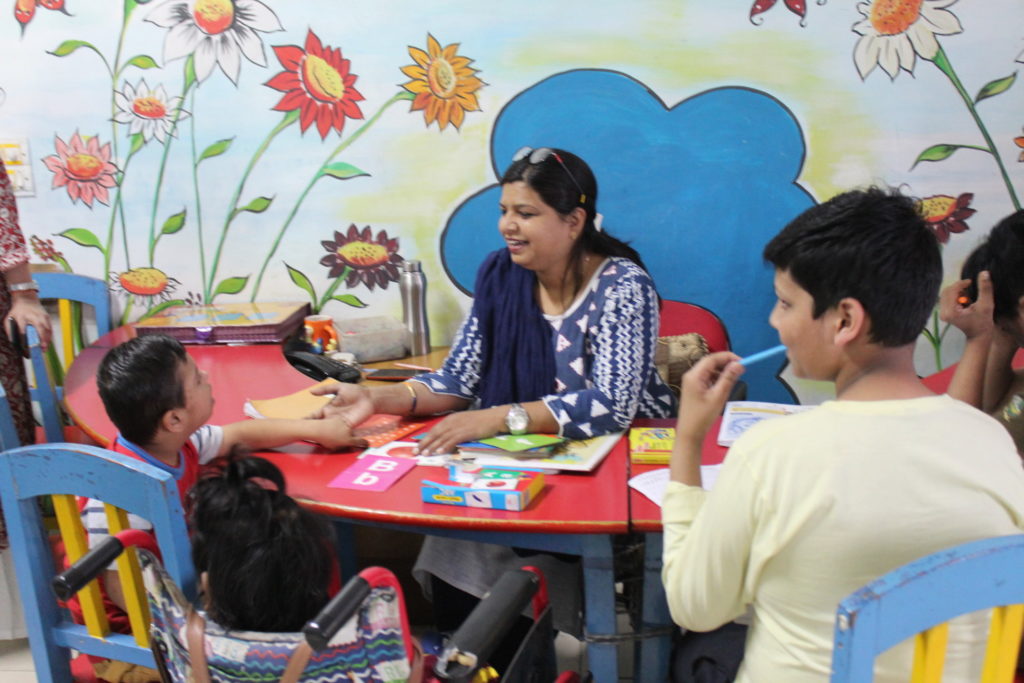
The school-readiness program at Arushi includes preparatory techniques such as perceptual training, sight-word and sign language learning. Children with visual impairment are given training in Braille, computer, mathematics, orientation and mobility; those with developmental delays and disabilities are provided with speech therapy and early language training; children with loco-motor disabilities are supported with therapeutic intervention, and; those with learning disabilities are given individual educational support.
Adaptive devices, instructional material in alternative formats, transport facilities, additional educational inputs and training in daily living skills are also made available. Once they acquire these skills, the children are admitted to regular schools and provided with back-up support.
3.4. Summer program
During the summer, several of the children attending regular schools, are at Arushi to attend the summer programme. Likewise, many children attend different activities after school regularly to continue with their therapy and intervention support. During the summer, the Arushi campus was buzzing with activity and excitement — theatre workshop in one area, computer classes in another, physio, hydro and speech therapy in yet another corner of the building along with singing and dancing – fill every inch and corner of the available space.
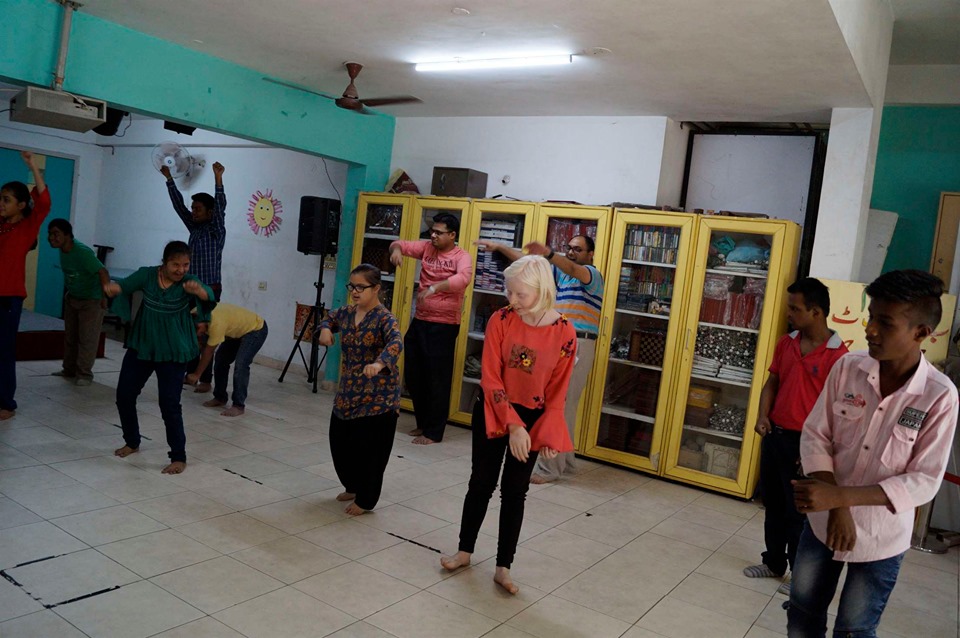
The beautifully designed, fully accessible building is a burst of colour and aesthetics. Children, as well as adults with multiple disabilities, navigate the entire campus independently using the railings, ramps, braille signs and tactile tiles provided at appropriate places.
The sense of abandon and happiness that one sees among all the members of Arushi – teachers, staff and students, is not just an endearing sight but speaks of the warmth and personal bonding that pervades among the members. The atmosphere of the centre is one of immense cheer and optimism. No child is crying or lost or unhappy. Each one is happy and involved in whatever they are doing – lessons, physiotherapy, speech or occupational therapy. The older children run around doing chores or helping the younger ones.
Sometimes, one does get the feeling that there is some attempt at ‘normalization’ or perhaps even denial of the special needs of the children in the manner that teachers and members of the staff interact with the children and adults with disabilities. It makes one wonder if this is a conscious but perhaps a bit overstated effort to diffuse boundaries that undeniably exist between the so-called ‘able-bodied’ and those with disabilities?
There is undoubtedly something unique about Arushi that distinguishes it from other organizations working at such a scale in the disability sector. There is a sense of adhocism that prevails in all functions and aspects of the organization. Not to be mistaken as casualness, one cannot help but notice the near-complete absence of structures, hierarchy and formal mechanisms to manage the fairly large and varied functions that Arushi has managed to operationalize. The same sense of informality is also visible in the interactions between the members of the staff and the children and adults who attend Arushi.
Finding out of the box solutions and a certain adhocism that seems to be their manner of operations is also linked to a deeply-lived philosophy of never making a task seem too overwhelming and taking everything in their stride. This mindset is helpful in keeping them going and never having to refuse help to anyone. They don’t seem to be too bothered about the ‘officious’ aspects of their work, like measuring impact, project plans, proposals, revenues or expenses. They believe in the goodness of people and believe that they will always find good people to help and support. People come to Arushi and see things that need to be attended to or items that they require, and they assume the responsibility. Another significant aspect of Arushi’s culture is that they connect with and take into their fold as many people as they are able to reach, who are interested. It is this that allows them to do so much and such varied work.
Acknowledgements: We deeply appreciate the help and support of our colleagues, Subrat Mishra, Prasad Kumar and Ritika Gupta who accompanied us on this visit. We are grateful for the media support provided by Prasad Kumar.
AUTHORS
Shefali Tripathi Mehta, Editor, University Practice Connect; Associate Editor, Learning Curve.
Ankur Madan, Associate Professor, Azim Premji University
The Hindi translation of this article is available here.

